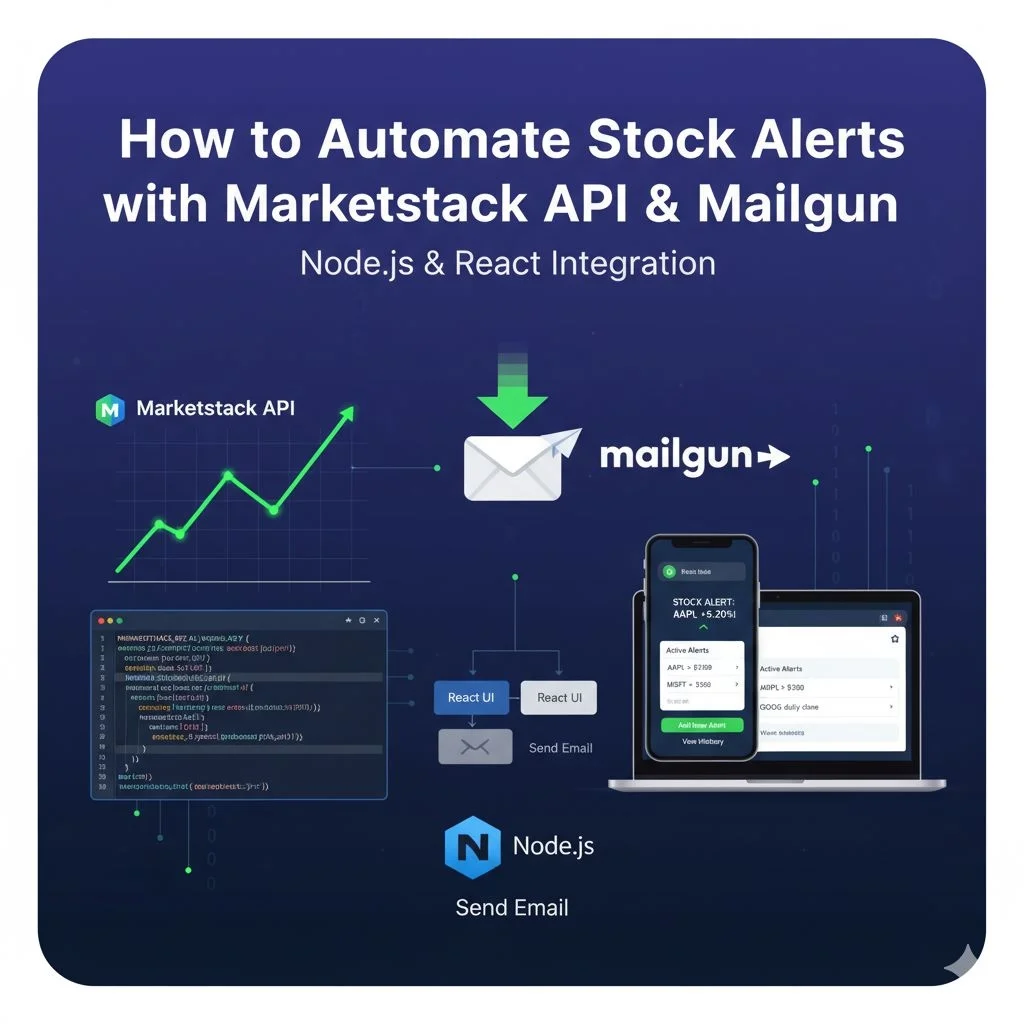Staying ahead of stock price movements is essential for investors, traders, and developers building financial tools. One of the most efficient ways to achieve this is by creating an automated email alert system for stocks. With the help of reliable APIs and automation frameworks, you can track live stock prices, detect real-time changes, and instantly notify users via email.
In this guide, we’ll explore how to build an email alert system for stocks with real-time stock alert integration, covering key concepts, tools, and practical steps for developers.
Why You Need a Real-Time Stock Alert System
The stock market is highly dynamic, prices can change within seconds due to global events, news, or market trends. Traders and investors rely on instant data to make decisions quickly. A real-time stock alert integration system allows you to:
-
Track price changes instantly: Get live updates for stock symbols of your choice.
-
Automate notifications: Send real-time email alerts to users when stocks cross certain thresholds.
-
Reduce manual monitoring: Eliminate the need to constantly refresh trading dashboards.
-
Enhance decision-making: Deliver timely information for better investment strategies.
For developers, this type of project also provides hands-on experience in working with APIs, event-driven architecture, and email automation systems.
Core Components of a Stock Email Alert System
To build an email alert system for stocks, you’ll need to integrate several key technologies and APIs that work together seamlessly. Here’s what the system typically involves:
-
-
Provides real-time and historical stock market data.
-
Supports multiple exchanges and stock tickers.
-
Allows you to set data update intervals for near-instant tracking.
-
-
-
Handles the sending of automated email alerts.
-
Offers high deliverability and easy integration with Node.js or Python.
-
Supports custom templates and dynamic content for each alert.
-
-
Backend Framework (e.g., Node.js):
-
Manages logic for fetching stock data and triggering alerts.
-
Runs on scheduled intervals or event-based triggers.
-
-
Frontend Dashboard (Optional, e.g., React):
-
Enables users to set alert preferences such as ticker symbols and thresholds.
-
Displays stock data visualization using charts and graphs.
-
Step-by-Step Guide to Building the System
Step 1: Gather Requirements and Choose APIs
Start by defining what kind of alerts you want, price changes, volume spikes, or specific percentage differences.
Then, select your APIs:
-
Marketstack API for reliable stock data.
-
Mailgun API for sending automated emails.
You can find detailed implementation guidance on both APIs in this tutorial on automated stock alerts with Marketstack and Mailgun.
Step 2: Fetch Real-Time Stock Data
Use the Marketstack API to retrieve real-time stock quotes:
const axios = require('axios');
const API_KEY = 'YOUR_MARKETSTACK_API_KEY';
const symbol = 'AAPL';
async function getStockPrice() {
const url = `https://api.marketstack.com/v1/eod/latest?access_key=${API_KEY}&symbols=${symbol}`;
const response = await axios.get(url);
const stock = response.data.data[0];
return stock.close;
}
This function pulls the latest closing price of the given stock symbol. You can modify it to fetch intraday updates or multiple tickers simultaneously.
Step 3: Set Alert Triggers
Once you have the stock data, establish conditions that trigger alerts. For example:
const alertThreshold = 175.00;
async function checkStockAlert() {
const price = await getStockPrice();
if (price > alertThreshold) {
sendEmailAlert(symbol, price);
}
}
This script checks whether the stock price exceeds the defined threshold and triggers an email notification when the condition is met.
Step 4: Send Automated Email Notifications
Next, use Mailgun to send the alert email.
const formData = require('form-data');
const Mailgun = require('mailgun.js');
const mailgun = new Mailgun(formData);
const mg = mailgun.client({ username: 'api', key: 'YOUR_MAILGUN_API_KEY' });
function sendEmailAlert(symbol, price) {
mg.messages.create('YOUR_DOMAIN', {
from: 'Stock Alerts
to: ['user@example.com'],
subject: `Stock Alert: ${symbol} crossed $${price}`,
text: `The stock ${symbol} has reached $${price}. Check your trading platform for details.`,
})
.then(() => console.log('Alert email sent successfully!'))
.catch(err => console.error('Error sending email:', err));
}
This automated email alert keeps users informed the moment their conditions are met.
Step 5: Schedule Regular Checks
To ensure your real-time stock alert integration works continuously, schedule your backend function using cron jobs or task schedulers like node-cron:
const cron = require('node-cron');
// Run every minute
cron.schedule('* * * * *', () => {
checkStockAlert();
});
This ensures that stock data is checked regularly, and alerts are sent without manual intervention.
Step 6: Add a User Interface (Optional)
Using a frontend framework such as React, you can create a dashboard where users can:
-
Enter stock symbols and price thresholds.
-
View live market data fetched from Marketstack.
-
Manage their email alert preferences.
Integrating a UI makes the application more user-friendly and suitable for broader audiences or commercial use.
Benefits of Building Your Own Stock Alert System
Creating a real-time stock alert integration system gives developers multiple benefits beyond convenience:
-
Custom control: You define alert conditions and delivery methods.
-
Scalability: Expand to cover multiple stocks or asset classes.
-
Learning opportunity: Gain practical experience in API integration, Node.js scheduling, and backend automation.
-
Monetization potential: Offer premium alerts or data insights as a subscription service.
Best Practices for Developers
-
Use environment variables to store API keys securely.
-
Implement logging for error tracking and debugging.
-
Limit API calls to avoid hitting rate limits from data providers.
-
Use HTTPS and authentication tokens for secure communication.
-
Add retry mechanisms for network failures or delayed responses.
Frequently Asked Questions (FAQs)
1. What is a stock email alert system?
A stock email alert system is an automated tool that sends notifications when specific stock conditions are met, such as price changes or volume thresholds.
2. Which API is best for real-time stock data?
The Marketstack API is an excellent choice for real-time and historical stock market data with simple integration and reliable performance.
3. How do I integrate email notifications into my stock alert app?
You can use an email automation service like Mailgun, which provides RESTful APIs for sending transactional and marketing emails.
4. Can I customize email templates for alerts?
Yes, Mailgun allows you to design custom templates and dynamically insert stock data for personalized notifications.
5. How frequently can I check for stock updates?
That depends on your API plan and system setup. With Marketstack’s real-time plan, you can fetch live updates every few seconds or minutes.
6. Is it possible to track multiple stocks simultaneously?
Absolutely. You can request multiple tickers in one API call or create parallel requests for different stock symbols.
7. Can I extend the system for SMS alerts?
Yes, by integrating an SMS service like Twilio, you can easily expand the system to send text alerts along with email notifications.
8. Do I need a front-end dashboard?
A dashboard is optional but helpful for managing user preferences, viewing analytics, and providing a better user experience.
Building an email alert system for stocks with real-time stock alert integration empowers developers to automate investment insights and deliver timely updates to users. With APIs like Marketstack for market data and Mailgun for email automation, the entire process becomes efficient, scalable, and adaptable to various use cases.
If you’re ready to take the next step and start coding your own system, check out the detailed step-by-step implementation guide here:
👉 How to Send Automated Stock Alerts with Marketstack, Mailgun, Node.js & React
This tutorial walks you through setup, integration, and testing, everything you need to create a fully automated stock alert system.






